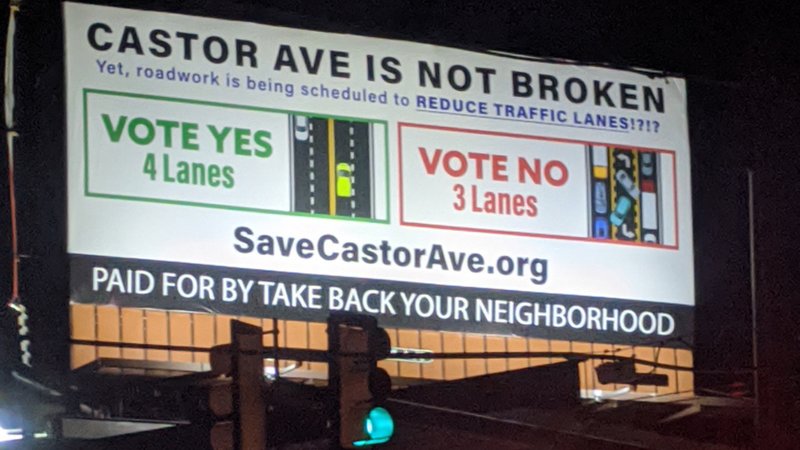
PHILADELPHIA (KYW Newsradio) — Plans are in the works to impose a so-called “road diet” on Castor Avenue in Northeast Philadelphia.
The project, by PennDOT and the city, would affect a 1.7-mile stretch of Castor Avenue from north of Oxford Circle to Cottman Avenue, reducing two travel lanes in each direction to one, with a center turn lane and a protected bike lane.
The civic group Take Back Your Neighborhood opposes the road diet, taking out a billboard in February that read “Castor Avenue is Not Broken.”
TBYN President Robert Rudnitsky said residents and businesses don’t see how narrowing the road will help.
“What will we be left with, with one lane? Where will the people park? Where will the deliveries happen?” Rudnitsky asked. “They’re able to use one of those two lanes as it is now for deliveries, and traffic goes by until that delivery is done. After this road is converted, everybody will be stuck in one lane. So, if a bus stops, everybody’s stopping. If one truck stops, everybody’s stopping.”
The current design of the roadway facilitates unsafe driving, said Andrew Simpson, a Complete Streets district manager for the city’s Office of Transportation and Infrastructure Systems.
"It promotes speeding, first and foremost, and aggressive driving. There's two lanes in each direction and we have a lot of folks turning, a lot of people trying to make turns, so you end up seeing a lot of weaving between lanes, going around turning vehicles," Simpson said.
In the last five years, five people have been killed and 15 seriously injured on that section, Simpson said.
"There is concrete evidence that these improvements do improve traffic safety and make streets safer," Simpson added.
Democratic State Representative Jared Solomon said, "You feel like you're taking your life into your hands when you're crossing over a corridor where people are driving 70, 80 miles an hour.”
Having a left turn lane will help traffic to flow more predictably, Simpson said. "You have a place to wait, so you're not waiting in a travel lane to make that turn and blocking traffic. You're in a dedicated turn lane."
"It's going to slow people down and make traffic move much more efficiently," said Solomon, whose district office is located on Castor Avenue.
The city would work with businesses to add more loading zones, Simpson said.
A community meeting to outline the plan is scheduled for Wednesday at 4 p.m. at Northeast High School.
After previous community input, PennDOT removed plans to put a concrete median in the roadway, Simpson said. "If someone was to double park or break down, it really restricts the movement on the corridor. So we removed that.”
Solomon disputed critics’ concerns that the changes would clog traffic along the Avenue. "Total, it's going to add 30 seconds to a rush hour drive.”
Under the current timetable, construction would begin in 2027, Simpson said.
